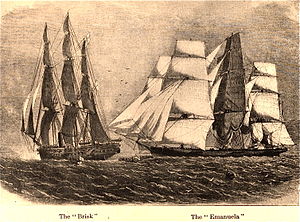HMS Brisk (1851)

Brisk captures the slave ship Emanuela
|
|
| History | |
|---|---|
|
|
|
| Name: | HMS Brisk |
| Ordered: | 25 April 1847 |
| Builder: | Woolwich Dockyard |
| Cost: | £47,482 |
| Laid down: | January 1849 |
| Launched: | 2 June 1851 |
| Completed: | 24 August 1853 at Devonport Dockyard |
| Commissioned: | 24 May 1853 |
| Decommissioned: | 19 January 1869 |
| Fate: | Sold on 31 January 1870 |
| General characteristics as built | |
| Type: | Screw sloop (corvette from 1862) |
| Displacement: | 1,474 long tons (1,498 t) |
| Tons burthen: |
|
| Length: |
|
| Beam: | 35 ft (10.7 m) |
| Draught: | 13 ft 9 in (4.2 m) (mean) |
| Depth of hold: | 20 ft 5 1⁄2 in (6.2 m) |
| Installed power: |
|
| Propulsion: |
|
| Speed: |
|
| Armament: |
|
HMS Brisk was a 14-gun wooden-hulled screw sloop of the Royal Navy, launched on 2 June 1851 from Woolwich Dockyard. She served in the Crimean War and as part of the West African anti-piracy patrol, as well as during the New Zealand land wars. She was sold in 1870.
Ordered from Woolwich Dockyard on 17 February 1847 to the same design as Rattler, she was re-ordered as an enlarged version on 25 April 1847. She was laid down in January 1849 and launched on 2 June 1851.
She was sent to the North America and West Indies Station on 24 May 1853 under Commander Frederick Beauchamp Paget Seymour. Her task was to stop slave boats.
When war was declared she was sent on 27 March 1854 to participate in the White Sea blockading Arkhangelsk under Sir Erasmus Ommanney's squadron. Returning to England in spring of 1854 she was then sent operations on the Russian Pacific coast. She was under Commander Alfred John Curtis from 20 October. On 1 June 1855 the squadron entered the harbour of Petropavlovsk, but found it abandoned. The batteries and magazines were then destroyed. On 7 June an eruption of Kozelsky was witnessed.
She was then assigned to the Pacific Station from 1854 until paying off at Plymouth on 13 June 1857.
From recommissioning on 5 May 1859 to the 24 February 1862, she served with the Cape of Good Hope Station under Captain Algernon Frederick Rous de Horsey. Apart from anti-slavery patrols, she also searched for Dr. Livingstone on 15 September 1859 at the River Kongone. In November she picked up the survivors of the Barretto Junior which had run aground on Mayotto Reef from Mayotto
...
Wikipedia
